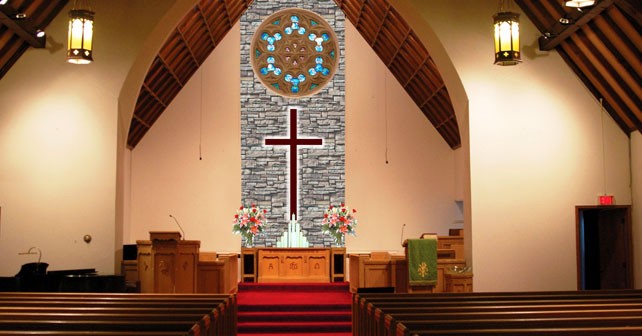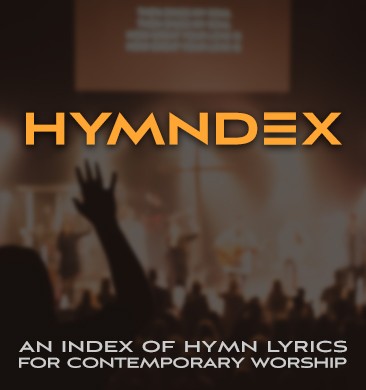Keith Drury comically compares church sanctuary lingo:
Tell us what you call that place up front in your church building and I bet we can tell you a lot about your church’s worship. The term you apply to the “up front area” in your church either affects or reflects your style or worship, probably both. There are three common terms Christians now use for the “up front” part of their church, and three styles of worship patterns related to the terms.
Three kinds of churches
1. Chancel Churches: If you call that up front area a “Chancel” you probably tend toward orderly worship, forms and predictable rituals in a sacred atmosphere. You probably claim your church does not “chase fads or try the latest relevant thing” in order to connect with people. You believe the ancient forms of worship are in fact relevant because they are not merely yesterday’s whim. You probably reject “excitement” as an important element of worship and value continuity with the past. You probably like to say the Lord’s Prayer in every service, and you might even recite a creed. You probably place significant emphasis on the Eucharist, and celebrate it more frequently than other churches, maybe even weekly. Symbolism is an important part of your church and the cross (probably several) is prominent in the interior and exterior of your building. Your Eucharistic table is probably a central furnishing though your chancel is rich with other articles, including both a lectern and pulpit, and you probably observe some of the liturgical year complete with changing colors of paraments. Your pastor probably wears a robe or even more complex vestments when “celebrating” the service. Your building probably has at least one window that is stained class, and you may even display at least one piece of art. Your worship is probably highly participatory with the pastor (or priest) leading the people who are expected to participate throughout the service and not merely serve as an audience. Your atmosphere is orderly, predictable—perhaps even sedate. People attending chancel churches often claim your worship service is a “haven of rest” or provides a “city of refuge” from their hectic lives. A chancel tends to beomce a place to perform acts of worship with or for the congregation.
2. Platform Churches: If you call that area up front a “platform” chances are you are a preaching church and your forms and rituals are more hidden rather than explicit. You probably combined the lectern and pulpit into a single central pulpit, and may have even later replaced that heavy wooden “sacred desk” with a lighter thinner wood model, or a Plexiglas see-thru pulpit, and maybe even more recently a music stand as you gravitate toward another style. Your set up is designed for speaking and listening—for preaching is the central act in worship with everything else leading up to or following up on the message. You probably have what you call the “Lord’s Supper” or “Communion” four times a year and believe if you did it more often you might “reduce its significance” or “take too much time from the sermon.” Music is important in your church but you see it as “leading people to the throne of God.” Once they are there it is time to preach—to “hear God’s word.” Your sermons are longer than chancel church homilies, but they are probably more interesting. In platform churches words are more important than actions, and there and lots of words—between songs, before and after every action, explaining what we are doing, instructing and applying truths for the people. Platform churches are designed to speak words to the people. As for the liturgical year, you probably celebrate only Christmas and Easter, you may have said more about Memorial Day that Sunday last May than about Pentecost. The atmosphere of your worship is interesting without being too extravagant. You believe people need “good solid food” in preaching or you think a worship service is “the time to draw the net” in winning people to Christ. A “platform” tends to become a place to speak to the audience.
3. Stage Church: If you call the up front area of your church a “stage” changes are your worship is often seen by people as “a power-packed experience.” The first part of your service is largely given over to musical praise and the latter part of your service is dedicated to “teaching” which is by far the most interesting presentation of the three church styles. You make heavy use of projection both in video and PowerPoint for both praise and preaching and “variety” is an important value to you in everything. In preaching the personality of the speaker is important and the teaching usually includes several personal stories. You might even have a minute-by-minute schedule for the services and you dislike “dead air.” Your stage area is probably packed with the accouterments of the band—drums, guitar stands, monitors, mic stands, and there are sometimes a dozen or more people on the stage at once during “worship” (what you call the first part of the service). The lights in the “audience” are often kept lower and people usually stand for the entire praise segment of the service. You may “serve communion” at an evening service several times a year, or perhaps on Christmas eve to families who come and go, but this rite is not central to morning worship. Even though you use the term “stage” you fight hard against “worship becoming a performance” and urge participation though you are frustrated by many who seem to “come for the show but refuse to grow.” When people describe your worship they often use terms like “high energy,” or “exciting.” A “stage” tends to become a place to perform for the audience.
4. Is there a fourth category? Most churches are not pure chancel, platform or stage churches, but are somewhere in transition between one or the other, often trying to have the best of all three styles. Worship doesn’t fit neatly into these three categories. But there may be a fourth category emerging—the church with no “up front” at all. Some folk, especially young people, are tired of “performance worship” and are eliminating the “stage” altogether, placing the band on the side or in the back, and the leaders among the congregation with hand-held mics. In these services there is still strong visual projection, indeed sometimes of ancient icons and biblical paintings, or even short clips from the Jesus Film or other films. In these worship services the entire service is musical and spoken praise—there is no preaching at all-or they would say the preaching is in the music. The atmosphere varies from jubilation at time to other periods of quiet—even mournful—singing. It is soft, pensive, and blues-ish with the leader never being a ram-rod to the audience but rather nudges the group to sing. The leader model here is more of a gentle shepherd leading the flock rather than a cowboy driving the herd. The dominant sounds heard are the voices of other worshipers not the amplified voices of the leaders or the band. The leader’s voice starts the singing then fades out except to keep it moving. Sometimes all the instruments drop out for a long season and the collective voices are the only sound—in an almost haunting tone. Litanies are often interspersed with singing, and sometimes the worshipper pray silently or in hushed tones as an entire song is played from a CD in the background. If you entered one of these services you might not know where the “up front” is though you’d see the projection as central. No people would be up front. It might seem like hundreds of people were “having devotions simultaneously” with musical accompaniment Some of these services are called “postmodern services” but most of them are adapted and Americanized versions of the some of the ideas from the popular Taizé student worship from France. Worship comprised of all praise with no “up front” is designed to be personal even private and devotional.
So, while you may call the “up front” part of your church building a chancel, platform or stage, some younger people might not want any “up front” at all, at least for leaders or “personalities.” The “front” may become a screen and the focus may move from corporate worship led by visible leaders, to private and individual worship nudged by mostly-invisible leaders.
Sign up to receive weekly WorshipIdeas every Tuesday morning in your email:





